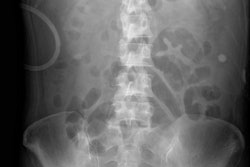
Greeted with fiercely mild weather for late November/early December, the 102nd RSNA show already had the feel of being a bit different. Of course, there was the packed program of fascinating research and exhibition halls bursting with advanced imaging hardware and cutting-edge IT solutions. But there was also the growing feeling, perhaps spurred by the theme "Beyond Imaging," that radiology is in a mode of transition.
This was perfectly exemplified near the entrance to exhibition hall B, where a radiology printed textbook stall was positioned next to an artificial intelligence software vendor. Amongst the glitz of RSNA, it's easy to forget that much on show is a long way from having an immediate impact on the daily working practice of most radiologists, but it is a great chance to gauge where radiology is heading.
With that in mind, here's how I see the key themes from the event.
Artificial intelligence everywhere
There was no way of avoiding artificial intelligence (AI). It was the top of the agenda for most discussions and a raft of new vendors were in attendance. While AI's role in radiology has already been discussed at length (and in my recent AuntMinnieEurope.com column too), the show did at least offer some more insight into the likely timescale for adoption and how it might fit into everyday use.

Consensus seems to suggest automated quantitative tools and computer-aided diagnosis systems based on AI will become available in the next one to three years. However, most will not necessarily offer new clinical insight or data, with many automating clinical tools that are already in use.
Computer-aided diagnosis and decision-support tools were also on show, though the release date for these more complex solutions is far harder to predict. Estimates range from three to 10 years for some specific use cases and a very broad 10 to 20 year prediction for AI to be equivalent to full radiologist capability. Regulatory, legal, and ethical hurdles all need addressing first, not to mention the issue of data interoperability (more on that later).
There was also far less focus on the idea that AI would replace radiologists than recent coverage has suggested. Instead, AI was being positioned as an "enabler" of quicker, more accurate diagnosis in partnership with human radiologists. In addition, many sessions and demos focused on allowing radiologists to take a more active role as an imaging specialist in multidisciplinary teams.
Less hardware, more screens?
Impetus on IT rather than hardware also seemed more pronounced. There was of course a huge range of modalities and high profile launches on show, but somehow hardware seemed to playing second fiddle to the swathes of IT workstations. While this may be inevitable, it is easy to forget the huge strides in the quality, efficiency, and capability of imaging hardware today compared with even a decade ago. I recently read the top trends of RSNA 2006, describing 16- and 32-slice CT as "the industry standard," so we've come a long way in a decade.
From a "big iron" perspective, the two major trends in 2016 remain multimodality imaging and workflow efficiency. PET/CT, SPECT, and hybrid interventional x-ray with CT were all again present in various configurations. At the other end of the spectrum, the range of more affordable and efficient 1.5-tesla MRI and 64/128-slice CT dominated, as well as a broader choice in 3-tesla MRI systems.
Most prominent in hardware was the ever-expanding clinical reach of ultrasound, with breast and musculoskeletal imaging seeming to take a lead in focus, not to mention "live scanning" on the show floor for the first time in 26 years (what took so long?).
It was evident just how far ultrasound has come in terms of technology in the next generation of top-end systems. Almost every offering had a dizzying array of functionality, ranging from fusion imaging, 4D, shearwave elastography, and contrast-enhanced ultrasound (CEUS), not to mention touchscreens and tablet-based remote control.
However, most of these hardware innovations will be used in top-end academic research institutions for the foreseeable future. For the working radiologist, then, hardware trends at RSNA can be easily summarized: faster, more powerful, and relatively less expensive.
Redefining value
The method in which imaging hardware and IT is procured also appears to be on the turn. While capital expenditure still dominates today, the focus on value and outcome has forced innovation in procurement and business models too.
The managed service model is certainly gaining momentum, offering set-term, set-fee for complete packages of hardware and IT, thereby eliminating unforeseen cost for the health provider and making budgeting more predictable. "Risk-sharing contracts," in which the technology vendor is paid based on the outcome or value their technology provides to the heath provider, were high on the agenda. While still relatively new, it's an approach that will certainly gain traction in the U.S. and in Europe as health provision is driven toward sharing financial risk across the payer-provider-vendor chain.
Cloud solutions for imaging IT is also slowly gaining traction, with vendors describing the transition now with an air of inevitability. Health provider security concerns still exist, but the volume, complexity, and access of imaging data today demand more agile, flexible IT solutions that only cloud can really offer. Near-constant query and retrieval of data required by AI and machine learning solutions will also be a big factor soon, meaning cloud becomes the only option capable of handling such demand at scale.
The Achilles' heel?
One could walk away from RSNA under the "Beyond Imaging" banner believing radiology has never looked so progressive, futuristic, and essential to modern medicine. In many ways, you would be right -- RSNA 2016 did offer a glimpse into the future, and a purposeful stride toward a greater role in interdisciplinary diagnosis should be welcomed.
Yet under the surface, one big unanswered issue simmered: interoperability.
 Stephen Holloway is principal analyst and company director at Signify Research.
Stephen Holloway is principal analyst and company director at Signify Research.It is not an easy topic for vendors or providers. Radiology has a better reputation on interoperability compared with, say, the electronic medical record (EMR), because DICOM-standards are well established and EMR data-blocking appears to be rife. However, most people in the industry know that rigorous DICOM standards do not prevent proprietary data-blocking from creeping in. Most imaging IT innovations on show also appeared to focus on building more capability and breadth of offering within the limits of their own towers, rather than focusing on collaboration.
Interoperability is now more widely discussed and touted in marketing, but few vendors or providers appear to have truly taken it to task. Imaging is big business, and as AI expands its reach, health data is the new currency. Therefore, the appetite for full interoperability becomes harder to foresee under the current model without a major overhaul or better legislation.
While "Beyond Imaging" offers so much promise of improved diagnosis and a bigger role for radiology in provision of care, progress will be painfully slow without banishing the proprietary standards and data protectionism of the past.
Stephen Holloway is principal analyst and company director at Signify Research (www.signifyresearch.net), a health tech, market-intelligence firm based in Cranfield, U.K.
The comments and observations expressed herein do not necessarily reflect the opinions of AuntMinnieEurope.com, nor should they be construed as an endorsement or admonishment of any particular vendor, analyst, industry consultant, or consulting group.



















